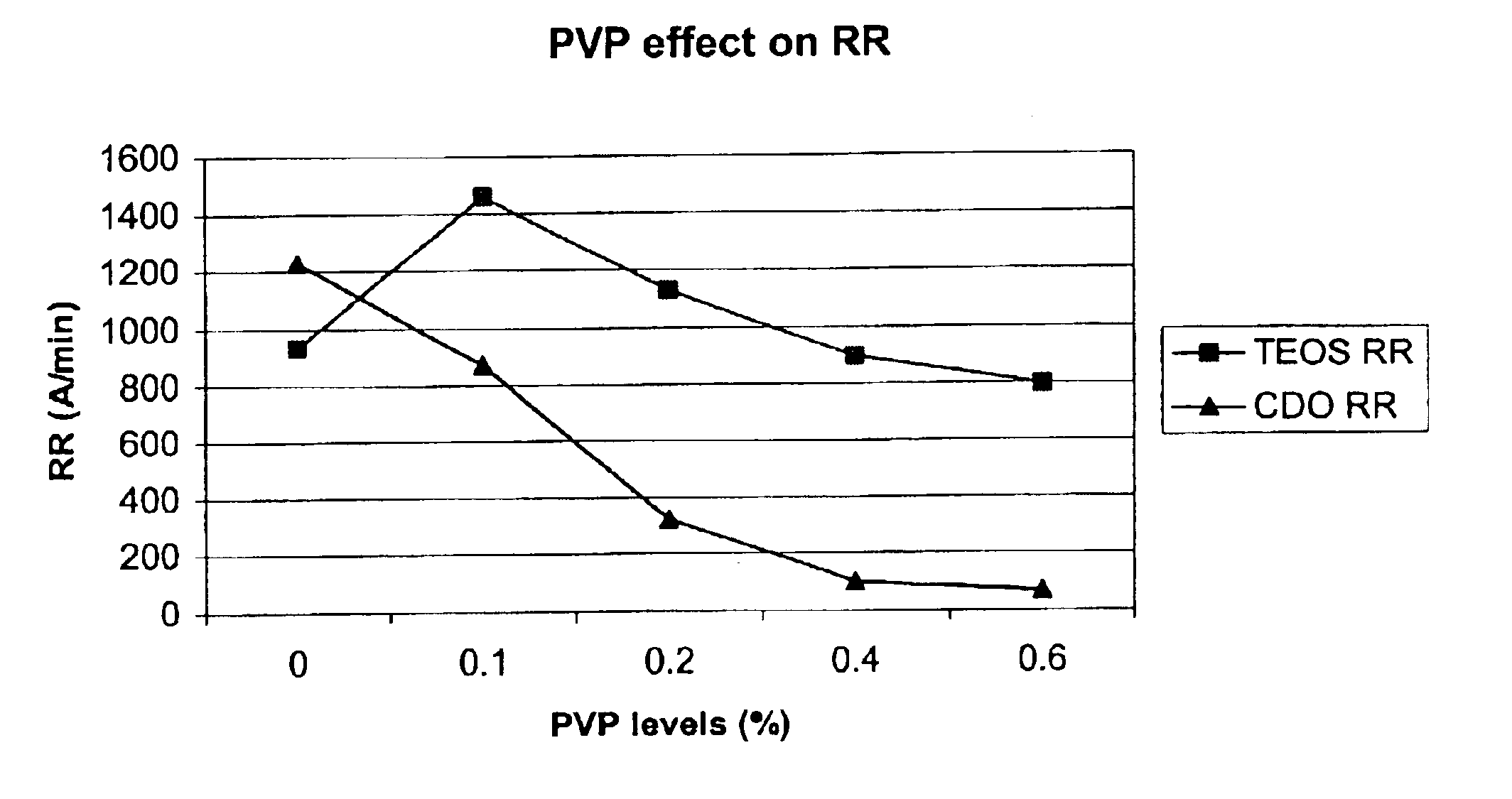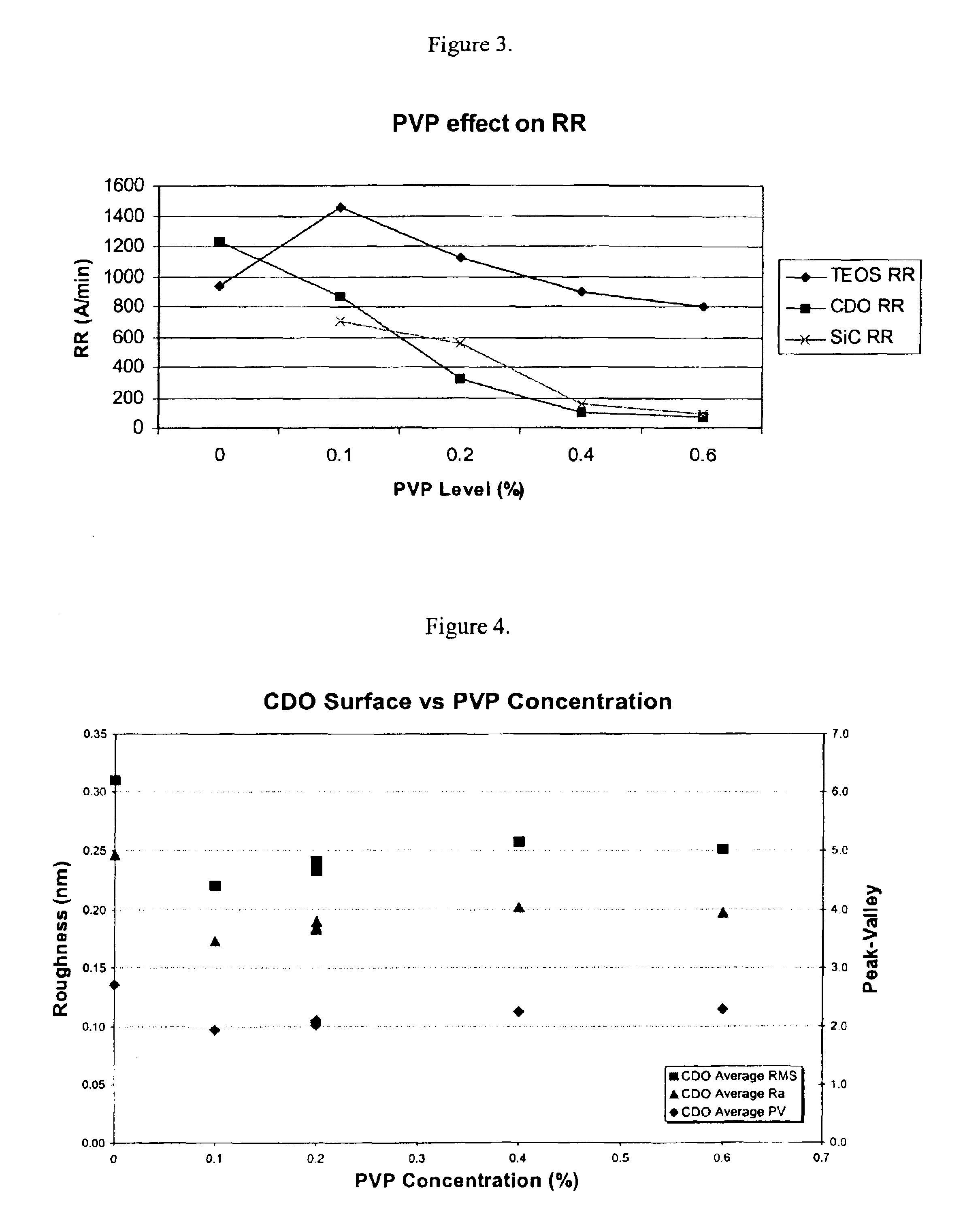Modular barrier removal polishing slurry
a technology of module and polishing slurry, applied in the direction of polishing compositions, other chemical processes, silicon compounds, etc., can solve the problems of low mechanical strength of low-k and ultra-low-k materials, inability to remove low-k films from wafer substrates, and extreme diversity of low-k/ultra-low-k integration architectures. achieve the effect of decreasing the removal ra
- Summary
- Abstract
- Description
- Claims
- Application Information
AI Technical Summary
Benefits of technology
Problems solved by technology
Method used
Image
Examples
example 1
[0028]The following Table illustrates the impact on removal rates with a 3 psi (20.7 kPa) down force for various semiconductor constituents.
[0029]
TABLE 2SlurryPVP(%)TEOS RRCDO RRCu RRTaN RRA0933122787102010.11457867241142120.2129434770119040.4895100294104060.6795673241007RR = Removal Rate
[0030]The addition of PVP, as plotted in FIG. 1, shows that the CMP polishing process removes both TEOS (capping material) and low K materials (CDO) for slurries lacking PVP. But adding PVP to the slurry, however, allows the slurry to selectively remove TEOS film in relation to low-k films. Therefore, this formulation allows chip fabricators to provide chemical mechanical planarization and stop on a low-k film. For example, some dual hard mask / cap integration schemes will require removing a TEOS cap while stopping on a SiC or CDO layer. For these integration schemes, slurry 4 that has a high TEOS removal rate and stops on SiC provides an excellent solution.
example 2
[0031]The following Table confirms the effects of PVP for SiC wafers and illustrates the effect arising from decreasing down force to 2 psi (13.8 kPa).
[0032]
TABLE 3SlurryPVP(%)TEOS RRSIC RR*TaN RRCDO RRA055155794583310.1738697123758520.2615393102526340.45021639966960.643890101740RR = Removal Rate
[0033]As observed in Example 1, CDO removal rate decreased with the increase of PVP in slurry. In addition to this, as illustrated in FIG. 2, the PVP addition also decreased the SiC removal rate. Because of the relative hardness of SiC to CDO, the SiC removal rate is typically much lower than the CDO removal rate for most polishing slurries. But the PVP-containing solutions showed generally higher SiC removal rates than CDO removal rates.
example 3
[0034]The following series evaluates the solid concentration effect for slurries having 8.5 weight percent silica on the SiC and CDO wafers with a 2 psi (13.8 kPa) down force.
[0035]
TABLE 4SlurryPVP(%)TEOS RRSIC RRTaN RRCDO RRB041038669457980.2375215902150110.62976280739RR = Removal Rate
[0036]As observed in the earlier Examples, PVP lowered the CDO and SiC removal rates. FIG. 3 illustrates the dramatic effect on low-k removal rates achieved for the slurries of Table 4.
PUM
| Property | Measurement | Unit |
|---|---|---|
| zeta potential | aaaaa | aaaaa |
| particle size | aaaaa | aaaaa |
| pH | aaaaa | aaaaa |
Abstract
Description
Claims
Application Information
 Login to View More
Login to View More - R&D
- Intellectual Property
- Life Sciences
- Materials
- Tech Scout
- Unparalleled Data Quality
- Higher Quality Content
- 60% Fewer Hallucinations
Browse by: Latest US Patents, China's latest patents, Technical Efficacy Thesaurus, Application Domain, Technology Topic, Popular Technical Reports.
© 2025 PatSnap. All rights reserved.Legal|Privacy policy|Modern Slavery Act Transparency Statement|Sitemap|About US| Contact US: help@patsnap.com



